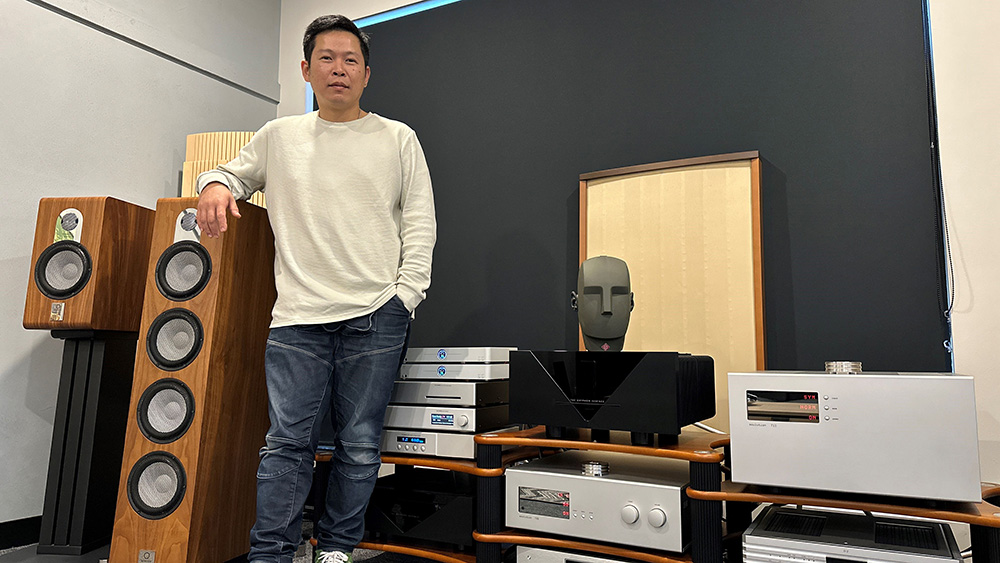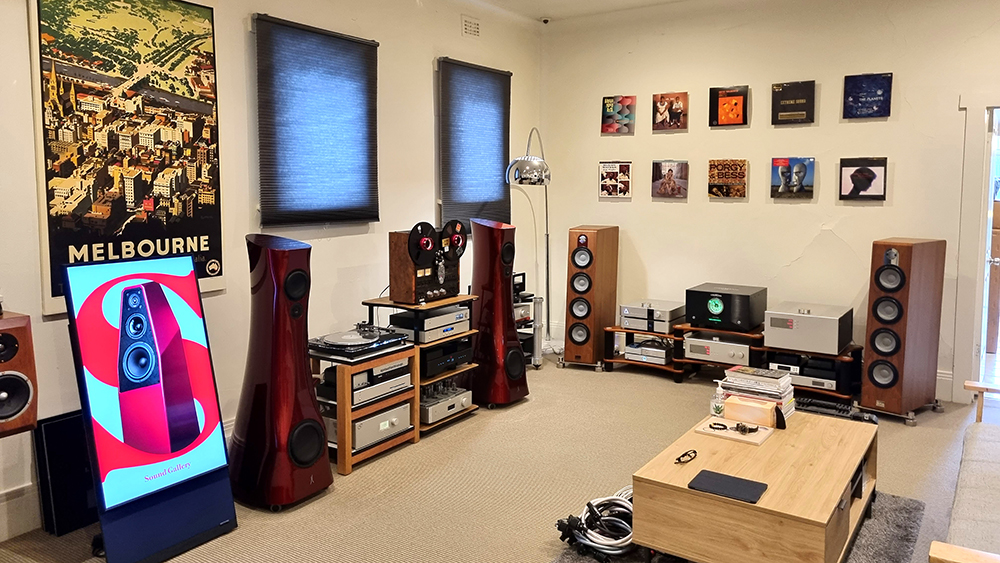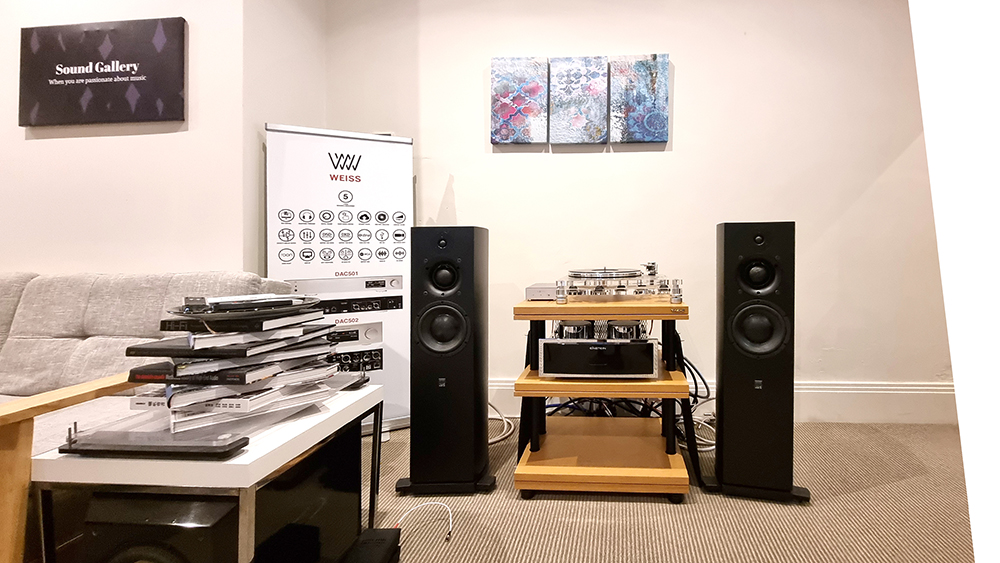From Malaysia to Melbourne: the story of John Ong's Sound Gallery hi-fi store
Ong’s audio experience began with an epiphany in a Malaya hi-fi shop at the age of 14...

It’s Kota Bharu in the remote Malaysian state of Kelantan. The day is hot and sticky and a young John Ong anxiously opens an envelope with his school report. It would be a passport out of the traditions of a developing country he loved but wanted to escape. The siren call of the masjid had little relevance to the bright young man whose love of Pink Floyd and Led Zeppelin lured him away from it like Orpheus.
Australia was the land of his Golden Fleece. Its nomenclature was audio. It seemed unattainable and couldn’t be possessed. “Education was the key to my new life and career,” he says. Ong eventually secured a spot at Queensland University and graduated in mechanical engineering, with the aim of somehow working in audio. “I got off the boat in 1998,” he joked, to pursue a life in hi-fi.
Ong’s audio experience began with an epiphany in a Malaya hi-fi shop at the age of 14. “The young salesman educated me in one hit, sonically and musically,” he says. “He played a form of rock music I hadn’t heard before on a quality system.” It was a life-changing revelation.
Western music wasn’t banned per se, but it was underground; you had to know someone who knew someone. But some stores were permitted to carry it. That was commerce.
“It knocked me out,” continues Ong. “I came to hi-fi through sound – the sound of Pink Floyd.”
Malaysian kids used short-wave radio to hear rock music like Pink Floyd, much like Radio Caroline broadcasting into England from a pirate ship in the 1960s. The Malaysian government reflected the BBC attitude of that time, restricting but not strictly banning pop music. “It wasn’t part of our culture or media, you had to look for it,” remembers Ong, recalling the difficulty of accessing the genre, particularly in Kelantan. “I just loved the sound of it.”

His mother said that if he got ten straight A’s at school then she would buy him a good system to play it. When he got nine A’s, she bought him a lesser, ‘entry point’ system. She was a tough marker! My parents were business people and I was the only son,” he says. “I was expected to do well.”
The latest hi-fi, home cinema and tech news, reviews, buying advice and deals, direct to your inbox.
“In Asia, you have to get top results, you have to be a straight ‘A’ student. My parents were business people and saw the JBL system as an investment. Lots of American ‘boom, boom’ for me,” he laughs.
But it was the spectral sound of Floyd that struck him most, not strictly the band’s musical content. “My first thought was ‘is anyone going to sing?’” he recalls. “I didn’t know! I was new to Pink Floyd, after all. And then came the vocals and I fell in love after understanding the context of the guitar intro.”
The hi-fi bug became a fixation when he later heard an old-school pair of Spendors. The salesman suggested the smaller speaker would be better; it’s not the size of the speakers that counts, he suggested. For Ong, that in itself was an education. So much for his desire for ‘boom, boom’ speakers. He wanted quality.
That day, he learned the art of critical listening when he heard a tapping sound, only to find that it was coming from the rear of the speaker. He looked around and there were only two speakers, not four. That spatial sound — the dynamic of two speakers producing a surround sound ambience — sparked his imagination and indirectly led him to mechanical engineering some years later. “Anything electrical, mechanical or machined, I like it — be it electronics, watches, cars, speakers you name it,” he said. He was in Australia studying by then. Of course, he graduated with honours.
Ong met his mentor, Surya Moorthy, shortly afterwards at Absolute Hi-End in suburban Hawthorn. The chance meeting determined his future, whereupon he stayed in Melbourne instead of returning home. Moorthy taught him “everything about sound and business” before he opened his own outlet years later, in a leafy Melbourne suburb in 2016. The Sound Gallery business grew quickly, before expanding into its current premises on Koornang Road, Carnegie, where I was able to sit down with Ong...
"I call hi-fi a passion; it’s been my life"
Peter Xeni: How do we accurately measure sound? There are so many variables and speaker signatures... they can’t all be right?
John Ong: A binaural head is the most accurate device to measure sound rooms and speakers specifically. There’s a microphone in each ear that reduces the ear loop factor that affects accuracy when measuring system responses. We measured literally lots of the world’s finest speakers and none of them — I repeat, none of them — were accurate with a flat frequency response. This is the only device that measures properly and we often use it at Sound Gallery to measure room resonances to provide the best speaker placement.
Everybody’s taste in all realms differs. Food, art and especially music appreciation are different and can be cultural. Depending on the mother tongue, the way we perceive sound differs. I’ll return to tune and retune it, to meet a buyer’s expectations. Accuracy is not always the case. We can’t always use this device in setting up home systems because our sound perception is emotional; it can’t be measured.
I suppose you guide them; play them music to suit the suggested system...
I never, ever try to sell, that is not what we do here. I call hi-fi a passion; it’s been my life. I ask them what they want from their system. If I hear they have a good system, I might suggest they just tweak it, not change it.
Some of my regular customers say, “I’m bored, I just want to change the system.” They just want something different. For many it is a hobby, and with other audiophiles it is sometimes a competition thing among their friendship group. I’ve found the whole gang will then buy the same item; it’s boring for me because it’s more interesting if they each buy something different!

Every hi-fi generation seems to think they are closest to the truth, but are some audiophiles only hearing differences?
We are getting to closer to the truth, to be fair. We are getting closer (though still not close) compared to before, and that has led to advances. Back then, we as an industry didn’t have the machinery, the engineering, the technology. We are now more precise. Take the turntable, for example: we now have the machinery for manufacturing that can get to microscopic levels to make things much
more accurate.
If we talk about digital, we have a long way to go. But with vinyl, it’s mechanical. There’s no 16-bit/44.1kHz or 24-bit/192kHz, no decoding, no DSP whatever. It’s a case of how good your stylus is, how good the tonearm is and how good the turntable’s setup is. It’s like ‘scrape, scrape, scrape’ back to the finest detail mechanically.
The studio speakers on which great artists like Aretha Franklin and Solomon Burke recorded music are inferior to those in today’s domestic environments, so why buy something superior just to play Kraftwerk!?
I can’t help but analyse every sound I hear when I’m working, but I shut down that analytical part of my listening experience at home; I just listen to the music. I love [Jascha] Heifetz, the violinist, and I don’t care if the 1940s or 1950 recordings are not of today’s audio standard. It’s the music I listen to. To be frank, we probably need three or four systems of different characteristics to do justice to the various recordings and genres!
Why does an older recording, say Elvis’ Sun Records 45s sound so constricted on a modern system and yet so exciting on a smaller one?
The older speakers’ designs usually have big bass drivers. Definition and resolution are not factored into the design at that time, it is simply covering the sound spectrum between the cut-off points of human hearing, 20Hz to 20kHz. The engineers will roll it off and boost the bass at some point, to make it more impactful. To make it fat — ‘boom, boom’! So when you listen to older recordings on older systems, it might sound more comfortable but it will likely be boomy in a modern system.
Why do some people enjoy inaccurate sound systems? Especially, say, heavy metal heads or Asian people who seem to like big bottom or high top ends.
Some Asians, for example, like the bright, sibilant sound because of the language and culture. It’s how their language sounds to them. The metal people like it bass heavy. They’re both inaccurate but it’s like adding spice to foods — some like it hot, others not at all. If it’s brighter, some people mistakenly think there’s more detail resolution. There is no right or wrong.
High End Munich: the hi-fi holy grail
Ong regularly attends the High End Munich hi-fi show and notes how the attendees select the best system in the show’s public competition.
“They’re mostly German people obviously, and it’s notable,” he says, choosing his words carefully. “The number one system they pick invariably sounds too forward, too harsh, not musical to my ears. They’re playing the Eagles, Fleetwood Mac, Diana Krall or Dire Straits. They are all a bit harsh to my liking. Then they play German music of any sort, which is characteristically Germanic, folk or even Kraftwerk — and suddenly it sounds correct. It has the right punch, the right rhythm, the right feel through the system.
The German language has that ‘u-gh, ach,’ sound, and all of a sudden my foot was tapping. Their preferred audio system shares that characteristic. That’s not the case with refined English folk music or Californian pop. The Poms like it smooth, warm and comfortable; the Yanks big, forward with lots of pronounced bass.”
And the Aussies? [Long pause]. “Well, it’s a mixed bag, because we are so multicultural. Everyone has a strong opinion here.
“If they don’t like my choice based on their musical taste, I take prospective buyers to another listening room [where Ong has separate set-ups]. The price is not the first point, it’s to ascertain the type of sound quality they prefer, and then we go through components that suit their budget.
“Many customers send a photo of their listening room at home, together with dimensions and furniture pics. The room is the most important factor in any sound system.”
The hi-fi show in Melbourne later this year will feature many of the brands at Sound Gallery. Ong says he will have a room to exhibit his hand-picked curation, including kit from Dan D’Agostino, Linn, Estelon, Gryphon and Wilson Audio, as well as DACs and network components from Weiss, the brand he imports from Switzerland.

Hi-fi at home
What system do you have at home?
I have four systems at home. For me, no single system can play everything well. I have only a limited time at night to listen to music, so I play what suits my mood at the time. On weekends, it’s family time, so when I do listen I select the more relaxed and musical system.
[Ong’s favourite personal system consists of a Kronos turntable with a DS Audio cartridge, a Weiss streamer and Ideon DAC, fed by CH Precision pre and power amplifiers, powered by a Stromtank battery power supply, and connected to Marten loudspeakers. Accessories include HRS racks and Stillpoints isolators.]
How do you think people will consume music in the future?
The evolution of music from vinyl 45s to LPs to cassette tapes to CDs was temporarily disrupted by MP3, and the idiom of portability and convenience was more affordable and more important for younger generations. Thousands of songs were released into the medium. Streaming and downloading etc — they hit big and will stay in the future. New habits formed with it, of course. It’s always “next track, next track”. Short attention spans are more common.
But in answer to your question, I think streaming will be the way music will be mainly consumed. Vinyl will always survive trends. It’s tangible, it’s art, it’s something the listener is compelled to listen to from track one to the end of side two. The ritual of cleaning and playing a record is a soothing process, too.
I remember my dad once telling me that human beings’ five senses are amazingly developed by knowledge; once you have tasted better food, smelled better smells, seen better views, touched better fabrics and heard better sound, it’s something you’ll never forget. The sound for me, I will always remember it. Hearing great music and the sound of it is something that, in that moment, I can always recall.
In closing this thought, essentially digital in any form will dominate. But the other extreme — analogue: vinyl — will be here forever too. I try to educate, demonstrate and show younger people what is possible with a good audio system. Education is the key.
And your favourites artists?
I don’t have any particular favourites really. I listen to Heifetz and to Miles Davis, and then Pink Floyd — ‘Division Bell’ is a favourite — maybe followed with Led Zeppelin for an adrenalin rush. Being Malaysian, I also listen to Asian music of various types. The blues, country and the Stones I know, but I have a broad taste in music.
I guess you’re ‘a sound man’ and American vernacular music is not in your DNA...
But Pink Floyd is... it’s a great sound.
MORE:
Australian Hi-Fi Show Sydney 2024 – dates, venue and ticket info
Step inside the world's best home cinema
Black Friday 2023 in Australia: time, start date and the best early tech deals
Australian Hi-Fi is one of What Hi-Fi?’s sister titles from Down Under and Australia’s longest-running and most successful hi-fi magazines, having been in continuous publication since 1969. Now edited by What Hi-Fi?'s Becky Roberts, every issue is packed with authoritative reviews of hi-fi equipment ranging from portables to state-of-the-art audiophile systems (and everything in between), information on new product launches, and ‘how-to’ articles to help you get the best quality sound for your home.
Click here for more information about Australian Hi-Fi, including links to buy individual digital editions and details on how best to subscribe.

